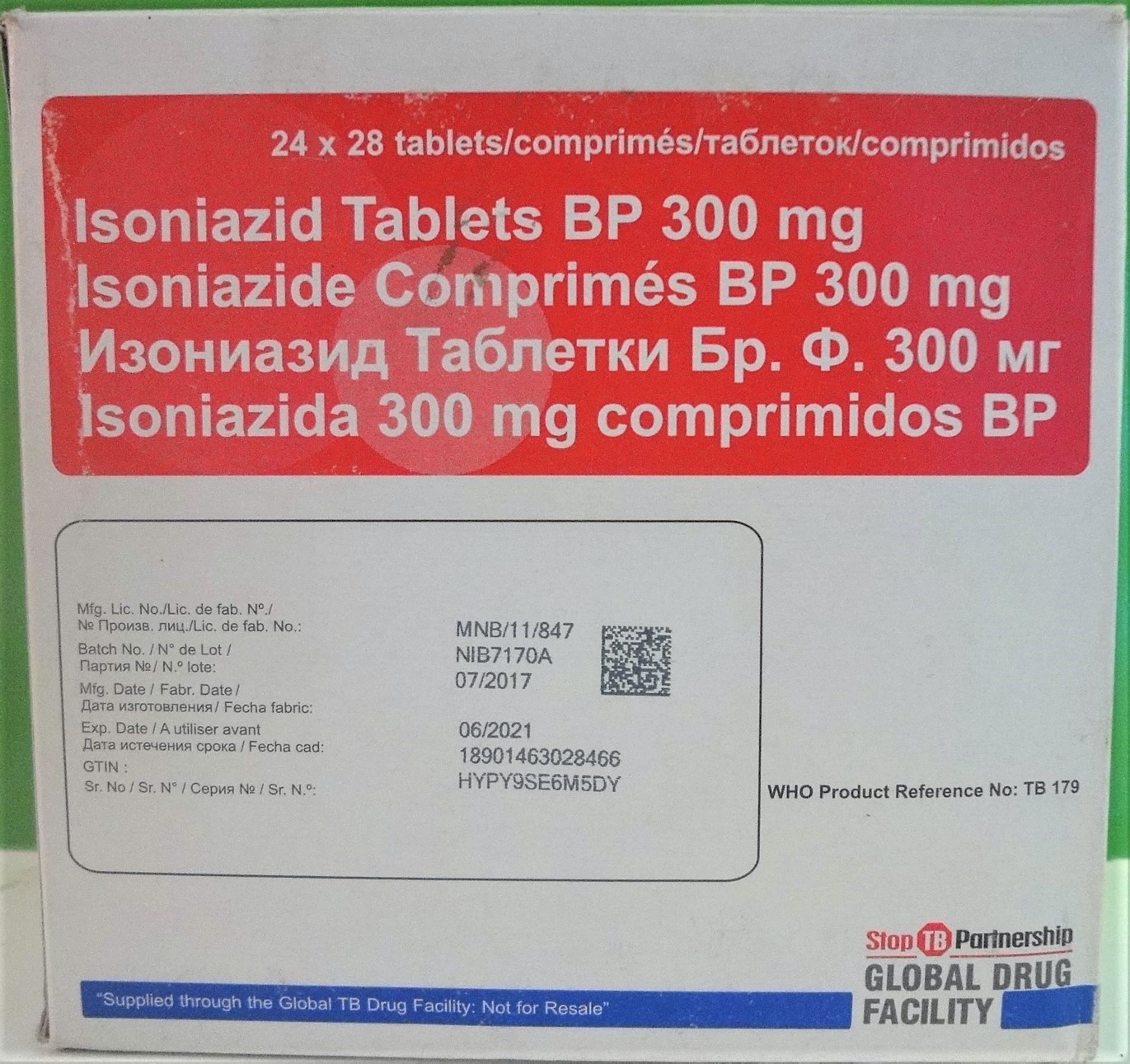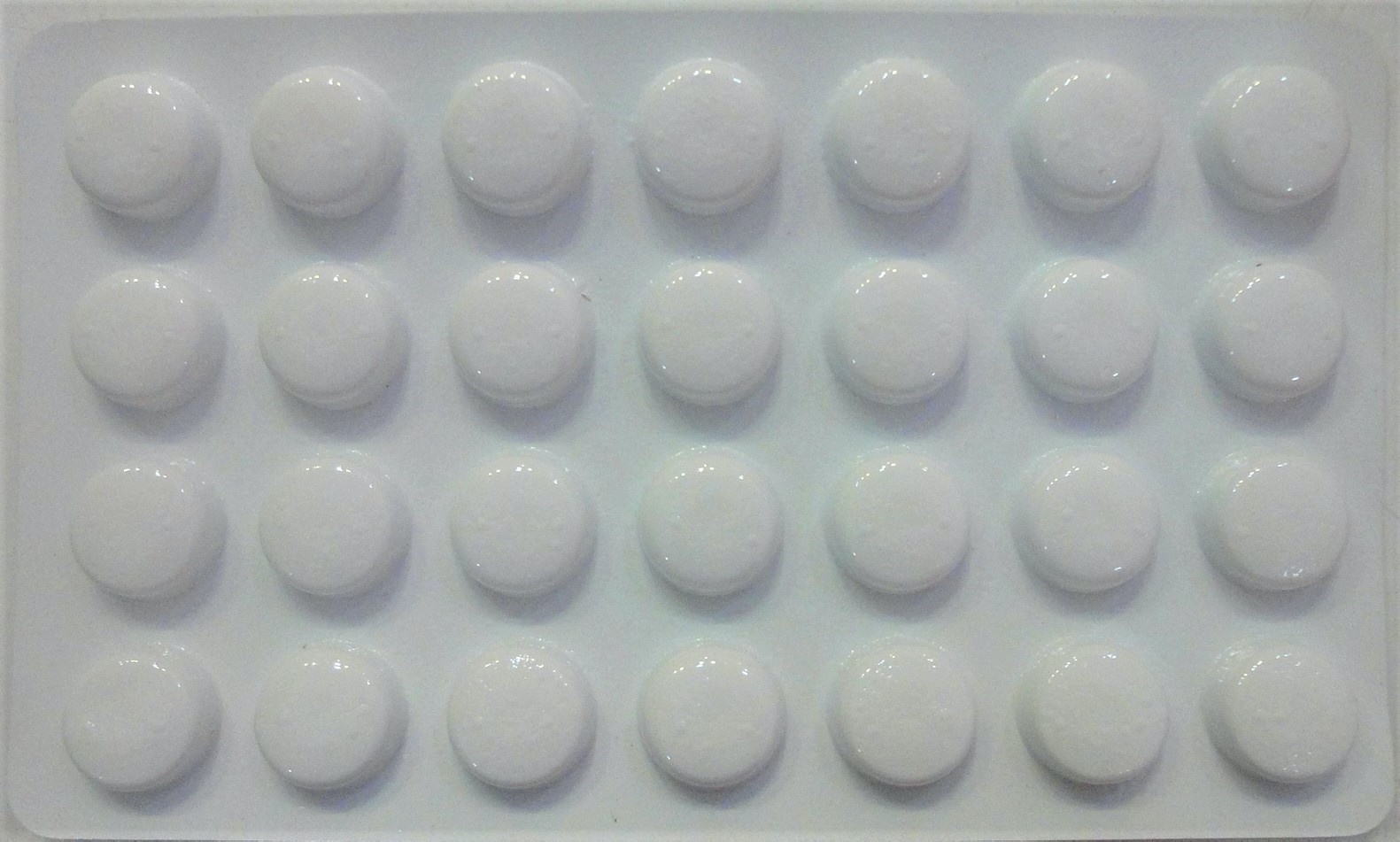ISONIAZID 300MG Tablet
ក្រុមហ៊ុនផលិតឱសថ:
OXALIS LABS, India


- សារធាតុសកម្ម
- ប្រសិទ្ធិភាពព្យាបាល និង កម្រិតប្រើប្រាស់
- ហាមប្រើ
- ផលរំខាន
- អន្តរប្រតិកម្ម
- ស្ត្រីមានផ្ទៃពោះ និង ស្ត្រីបំបៅដោះកូន
- ការប្រុងប្រយ័ត្នជាពិសេស បរិយាយប័ណ្ណឱសថ
-
សារធាតុសកម្ម
Isoniazid 300mg
-
ប្រសិទ្ធិភាពព្យាបាល និង កម្រិតប្រើប្រាស់
For the treatment of tuberculosis caused by Mycobacterium tuberculosis.
Dosage
The dose of Isoniazid 300mg Tablets was decided by your doctor based on your body weight. Also, the dosing intervals (daily or thrice weekly) most suitable for you were selected by your doctor or health care provider.
ACTIVE TUBERCULOSIS
Daily therapy
In patients weighing more than 45kg the daily dose is 1 tablet to be taken one daily.
Patients weighing 45kg or less should not take Isoniazid 300mg Tablets, as appropriate dose adjustments cannot be made. For these patients other formulations containing less isoniazid are available.
LATENT TUBERCULOSIS
In adults the daily dose is 300mg (1 tablet as a single dose) for at least 6 months.
Children should not take Isoniazid 300mg Tablets for this indication, as appropriate dose adjustments cannot be made. For them, other formulations containing less isoniazid are available.
Swallow Isoniazid 300mg Tablets whole with water or another drink.
The tablets should be taken on an empty stomach (at least 1 hour prior to or 2 hours after a meal).
-
ហាមប្រើ
- if you are hypersensitive (allergic) to isoniazid or any of the other ingredients of Isoniazid 300mg tablets,
- if you have acute liver disease,
- if you have drug induced liver disease,
- if you have experienced liver damage before when taking isoniazid,
- if you have experienced severe side effects of isoniazid, such as drug fever, chills or inflammation of the joints before.
-
ផលរំខាន
The most important adverse effects of isoniazid are nerve injuries and severe and sometimes fatal inflammation of the liver (hepatitis).
The most commonly reported side effects are sensations of tingling, pricking, or numbness of the skin, especially in the feet and hands (peripheral neuropathy). Also, increases of liver enzymes as measured in blood samples. Usually, these enzyme increases return to normal within 3 months despite continued treatment. When the values rise above a certain level your doctor may decide to stop treatment with Isoniazid 300mg Tablets.
Uncommon side effects are inflammation of the liver (hepatitis), epileptic seizures, inflammation of the brain, personality changes and memory impairment. If you notice sign and symptoms suggestive of liver damage, inform your doctor or health care provider immediately.
The following side effects have been reported in patients treated with isoniazid.
However, frequency estimates for these effects are not available:
- allergic reactions, including skin reactions, such as rash (exanthema, erythema) and/or itching (pruritus), but also severe forms with fever, blisters and involvement of the mucous membranes (e.g. erythema multiforme, Stevens-Johnson syndrome) inflammation of blood vessels (vasculitis), swollen and/or painful lymphnodes (lymphoadenopathy), painful disorder affecting joints, muscles and other soft tissues (rheumatic syndrome, lupus-like syndrome) or life-threatening anaphylactic reactions,
- dizziness, headache, overresponsive reflexes, tremor, vertigo,
- confusion, disorientation, hallucination,
- inflammation of the lungs (pneumonitis),
- build up of acid in the body (metabolic acidosis), increased blood levels of glucose, a vitamin deficiency syndrome called pellagra (with e.g. dementia, loose stools and skin inflammation)
- nausea, vomiting, loss of appetite, dry mouth, flatulence, constipation, abdominal pain
- difficulty in passing urine, kidney damage including kidney inflammation (interstitial nephritis)
- changes in the white blood cell counts (leucopenia, neutropenia, eosinophilia, agranulocytosis), possibly resulting in an increased risk of infection,
- decreased red blood cell counts (anaemia), possibly leading to fatigue, weakness and shortness of breath,
- decreased platelet count, possibly resulting in an increased risk of bruising and bleeding,
- inflammation of the joints (arthritis)
- visual changes due to inflammation of the optic nerve (optic atrophy or neuritis)
-
អន្តរប្រតិកម្ម
You should not take Isoniazid 300mg tablets with -aluminium hydroxide (medicine used to treat diseases related to the gastric acid) or - disulfiram (medicine used for the treatment of chronic alcoholism).
The active agent in Isoniazid 300mg Tablets may also interact with the following medicines:
- medicines to treat epileptic seizures (e.g. phenytoin, carbamazepine, valproic acid, phenobarbital)
- medicines used to help you sleep (benzodiazepines, e.g. diazepam, flurazepam, triazolam, midazolam),
- medicines for the treatment of certain psychiatric conditions (neuroleptics, e.g. chlorpromazine, haloperidol),
- medicines for prevention of blood clots (coumarin-or indandione - derivates, e.g. warfarin),
- medicines used prior to surgery (narcotics, e.g. alfentanil, enflurane),
- theophylline (medicine for the treatment of asthma),
- procainamide (medicine for the treatment of cardiac arrhythmias),
- corticosteroids (e.g. prednisolone, medicines for the treatment of inflammations and other diseases, such as asthma or rheumatoid arthritis),
- paracetamol (pain killer),
- medicines toxic to the liver,
- medicines toxic to the nervous system.
With food and drink
Isoniazid 300mg tablets should be taken on an empty stomach (at least one hour prior to or two hours after a meal).
If you take Isoniazid 300mg Tablets concurrently with cheese or fish, you may experience redness or itching of the skin, hot feeling, rapid or pounding heartbeat, swelling, chills or clammy feeling, headache, or lightheadedness.
Do not drink alcohol while taking Isoniazid 300mg tablets. This increases your risk for liver damage.
-
ស្ត្រីមានផ្ទៃពោះ និង ស្ត្រីបំបៅដោះកូន
If you become pregnant, or are planning to become pregnant, you must contact your doctor or health care provider to discuss the potential benefits and risks of your tuberculosis therapy for you and your child.
Isoniazid is excreted into the breast milk of lactating mothers. No negative effects have been reported in breast-fad-infants, whose mothers were receiving isoniazid.
However, drug concentrations in breast milk are so low, that you cannot rely upon breast-feeding for adequate tuberculosis prophylaxis or therapy for your child.
-
ការប្រុងប្រយ័ត្នជាពិសេស
You should promptly report signs or symptoms consistent with liver damage. These include any of the following: unexplained lack of appetite, nausea, vomiting, dark urine, yellowing of the skin and the eye white (jaundice), rash, tingling in the hands and feet, persistent tiredness, weakness lasting longer than 3 days and/or abdominal tenderness, especially in the right upper region of your belly. Your doctor or health care provider will control your liver function regularly.
You may be at special risk for developing hepatitis, if
- you are older than 35 years,
- if you drink alcoholic beverages daily,
- if you have a chronic liver disease,
If you belong to one of these groups your doctor will closely check your liver function.
Furthermore, you will be carefully monitored, if:
- you use any chronically administered medication concurrently,
- you suffer from tingling in the hands and feet (peripheral neuropathy),
- you are pregnant,
- you are HIV infected.
Peripheral neuropathy (tingling in the hands and feet) is the most common side effect of isoniazid. If you have kidney problems, you may be at increased risk of experiencing isoniazid side effects including peripheral neuropathy.
A certain vitamin, called pyridoxine, should be administered routinely at doses of 10mg per day during treatment will Isoniazid 300mg Tablets, since it largely reduces the risk of developing neuropathy.
If you are hypersensitive (allergic) to ethionamide, pyrazinamide, niacin (nicotinic acid), or other related medications you may also be hypersensitive to this product.
You should inform your doctor if you have diabetes or if you have severe suffered from seizure disorders (fits), psychosis, or liver problems.
It is important that your doctor or health care provider knows about all your symptoms even when you think they are not related to tuberculosis infection.
*ព័ត៌មានឱសថត្រូវបានរៀបរៀងដោយ អ៊ីម៉ាតុគឹ មេឌីក (ខេមបូឌា) ដោយផ្អែកលើប្រភពព័ត៌មានខាងក្រោម។ សម្រាប់ព័ត៌មានលម្អិត សូមស្វែងរកនៅក្នុងក្រដាសព័ត៌មាននៃឱសថនីមួយៗ ឬ សាកសួរទៅកាន់ក្រុមហ៊ុនឱសថឬតំណាងចែកចាយនៃឱសថនីមួយៗ។
ប្រភពព័ត៌មាន៖
- ក្រដាសព័ត៌មាននៃឱសថសម្រាប់អ្នកជំនាញវេជ្ជសាស្ត្រដែលប្រើប្រាស់នៅប្រទេសជប៉ុន (Pharmaceutical and Medical Devices Agency, Pmda): https://www.pmda.go.jp
- ព័ត៌មានសង្ខេបនៃឱសថសម្រាប់អ្នកជំងឺដែលប្រើប្រាស់នៅប្រទេសជប៉ុន: http://www.rad-ar.or.jp
